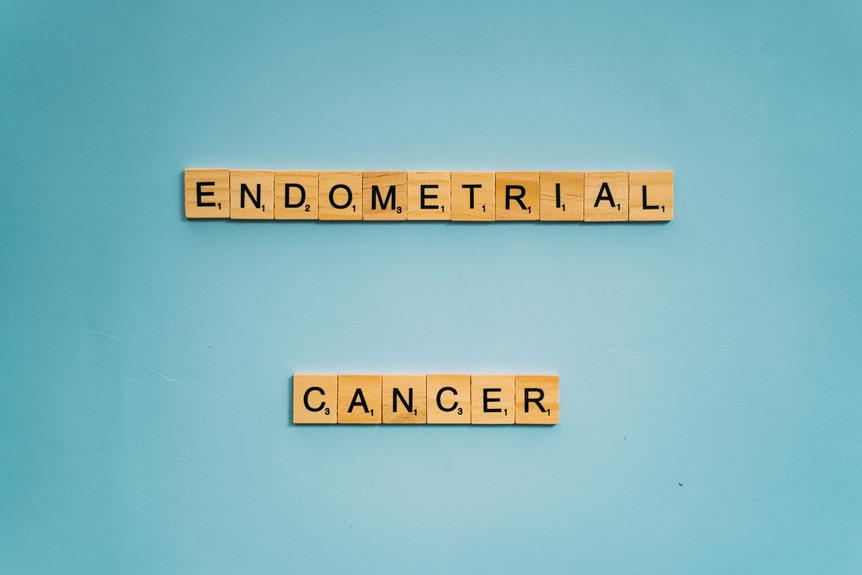What Is Endometrial Cancer and How to Spot the Signs

Imagine a vibrant, 45-year-old woman named Sarah. She leads an active lifestyle and embraces every opportunity life presents. However, Sarah recently noticed some unusual symptoms like abnormal bleeding and pelvic pain.
Concerned, she decided to seek medical advice. After a series of diagnostic tests, Sarah received a diagnosis of endometrial cancer.
In this article, we will explore what endometrial cancer is, how to spot its signs, and provide valuable information to help individuals like Sarah navigate their journey towards recovery.
Key Takeaways
- Early detection is crucial for optimal patient outcomes and maximizing chances of successful treatment.
- Common symptoms of endometrial cancer include fatigue, abnormal vaginal bleeding, pelvic pain, changes in bowel or bladder habits, and unexplained weight loss.
- Diagnostic tests for endometrial cancer include imaging tests (transvaginal ultrasound, MRI), biopsies, blood tests, endometrial sampling, and hysteroscopy.
- Treatment options for endometrial cancer include surgery, radiation therapy, chemotherapy, and alternative treatments such as hormone therapy and targeted therapy.
Risk Factors for Endometrial Cancer
There are several important risk factors for endometrial cancer, including obesity, age over 50, and a family history of the disease.
Prevention strategies play a crucial role in reducing the risk of developing endometrial cancer. Maintaining a healthy weight through regular exercise and a balanced diet is essential as obesity is strongly associated with this type of cancer.
Additionally, hormonal factors also contribute to the development of endometrial cancer. Estrogen levels that are not balanced with progesterone can increase the risk. Therefore, hormonal therapies, such as birth control pills or hormone replacement therapy, may be recommended to regulate hormone levels and reduce the risk.
Regular check-ups and screenings are also vital for early detection and treatment of endometrial cancer.
Common Symptoms of Endometrial Cancer
Fatigue and abnormal vaginal bleeding are two common symptoms of endometrial cancer, and early recognition of these signs is crucial for timely diagnosis and treatment.
Endometrial cancer is a type of cancer that affects the lining of the uterus, and it primarily affects women over the age of 50. It is important to be aware of these symptoms and seek medical attention if they occur.
When diagnosed with endometrial cancer, there are various treatment options available, including surgery, radiation therapy, and chemotherapy. It is essential for patients to discuss these options with their healthcare providers to determine the most appropriate course of action.
Additionally, joining endometrial cancer support groups can provide a valuable source of emotional support and information for individuals going through this journey. These groups offer a platform for sharing experiences, connecting with others, and accessing resources that can aid in coping with the challenges of endometrial cancer.
Diagnostic Tests for Endometrial Cancer
There are several diagnostic tests available for endometrial cancer, including imaging tests, biopsies, and blood tests. These tests play a crucial role in accurately diagnosing the disease and determining its stage, which is essential for effective treatment planning and prognosis.
Early detection through these diagnostic tests can significantly improve the chances of successful treatment and survival for patients with endometrial cancer.
Accuracy of Diagnostic Tests
The accuracy of the diagnostic tests for endometrial cancer is crucial in ensuring early detection and effective treatment. When it comes to such a serious illness, accuracy is of utmost importance.
Here are four reasons why accuracy matters in the diagnosis of endometrial cancer:
- Accuracy of biopsy: A precise and accurate biopsy helps determine the presence of cancer cells in the endometrium, enabling healthcare professionals to provide the appropriate treatment promptly.
- Effectiveness of imaging: Accurate imaging techniques, such as transvaginal ultrasound or MRI, can help identify any abnormalities or tumors in the uterus, aiding in the early detection of endometrial cancer.
- Avoiding misdiagnosis: Accurate diagnostic tests reduce the risk of misdiagnosis, ensuring that patients receive the correct treatment plan and avoid unnecessary procedures or delays in receiving adequate care.
- Improving survival rates: Early detection through accurate diagnostic tests significantly improves the chances of successful treatment and higher survival rates among patients with endometrial cancer.
Ensuring accurate diagnostic tests is vital for early detection, which leads to timely intervention and improved patient outcomes.
Importance of Early Detection
Early detection of endometrial cancer through precise and timely diagnostic tests is imperative for ensuring optimal patient outcomes and maximizing the chances of successful treatment. Regular screenings play a crucial role in identifying the disease at an early stage when it is most treatable. Advancements in early detection techniques have significantly improved the accuracy and efficiency of these screenings, allowing for earlier diagnosis and intervention.
These advancements include the use of transvaginal ultrasound, which allows for the visualization of the endometrium and detection of any abnormalities, as well as the development of molecular biomarkers that can identify high-risk individuals. By emphasizing the importance of regular screenings and utilizing these advancements in early detection, healthcare providers can play a vital role in detecting endometrial cancer early and improving patient outcomes.
Stages and Prognosis of Endometrial Cancer
Interestingly, accurately determining the stages and prognosis of endometrial cancer is crucial for guiding treatment decisions and improving patient outcomes. Endometrial cancer is the most common type of uterine cancer, and it is essential to understand the different stages and treatment options available.
Here are four important factors to consider when discussing the stages and prognosis of endometrial cancer:
- Early detection: Detecting endometrial cancer in its early stages increases the chances of successful treatment and higher survival rates.
- Treatment options: Depending on the stage of cancer, treatment options may include surgery, radiation therapy, chemotherapy, or a combination of these.
- Prognosis: The prognosis for endometrial cancer varies depending on the stage at diagnosis. Early-stage cancers have more favorable outcomes compared to advanced-stage cancers.
- Survivorship programs: Providing comprehensive survivorship programs can help endometrial cancer patients navigate the challenges of treatment and improve their quality of life.
Treatment Options for Endometrial Cancer
When it comes to treating endometrial cancer, surgery is often the primary treatment option. It involves removing the uterus and other affected tissues to remove the cancerous cells.
In some cases, radiation therapy may also be used to target and kill any remaining cancer cells after surgery.
Surgery as Treatment
Surgery, specifically hysterectomy, is commonly employed as a treatment for endometrial cancer to remove the affected uterus and surrounding tissues. While surgery can be highly effective in treating endometrial cancer, it is important to consider the potential outcomes and explore alternative treatments.
Here are four key points to consider:
- Emotional impact: Surgery can have a significant emotional impact on patients, causing fear, anxiety, and uncertainty about the future.
- Physical recovery: Surgery often requires a longer recovery period, which may impact a patient’s ability to resume normal activities and daily routines.
- Potential complications: Like any surgical procedure, hysterectomy carries risks such as infection, bleeding, or damage to surrounding organs.
- Alternative treatments: In some cases, alternative treatments like hormone therapy, radiation therapy, or targeted therapy may be considered as less invasive options with potentially fewer side effects.
When discussing surgery outcomes and alternative treatments, it is crucial to provide comprehensive information and support to empower patients in making informed decisions about their treatment plan.
Radiation Therapy Effectiveness
Furthermore, radiation therapy has shown promising effectiveness in treating endometrial cancer, providing an alternative option for patients to consider alongside surgery. Radiation therapy involves the use of high-energy beams to target and destroy cancer cells. It can be used either before surgery to shrink tumors or after surgery to kill any remaining cancer cells. While radiation therapy has proven to be effective in treating endometrial cancer, it is important to be aware of potential side effects. These may include fatigue, skin irritation, and changes in bowel or bladder function. However, it is essential to note that not all patients will experience these side effects, and they can often be managed with proper medical guidance. Despite these potential side effects, radiation therapy serves as a valuable alternative treatment for endometrial cancer patients.
Transition: In addition to considering radiation therapy and surgery, there are also lifestyle changes that can be made to reduce the risk of endometrial cancer.
Lifestyle Changes to Reduce the Risk of Endometrial Cancer
To minimize the risk of endometrial cancer, individuals can adopt healthy lifestyle changes such as maintaining a balanced diet and engaging in regular physical exercise. By making these lifestyle modifications, individuals can greatly reduce their chances of developing this type of cancer. Here are four prevention strategies that can be implemented:
- Eat a variety of fruits and vegetables: Consuming a wide range of colorful fruits and vegetables provides essential nutrients and antioxidants that help protect against cancer.
- Limit processed foods and sugary drinks: These products often contain high levels of unhealthy fats, added sugars, and preservatives, which have been linked to an increased risk of cancer.
- Stay physically active: Regular exercise not only helps maintain a healthy weight but also reduces the risk of developing endometrial cancer.
- Avoid smoking and limit alcohol consumption: Smoking and excessive alcohol intake have been associated with an increased risk of endometrial cancer.
By implementing these lifestyle changes, individuals can take proactive steps towards reducing their risk of endometrial cancer.
Transitioning into the subsequent section, it is important to discuss the support and resources available for individuals already diagnosed with this condition.
Support and Resources for Individuals With Endometrial Cancer
There are numerous support groups and online resources available to individuals with endometrial cancer, providing them with emotional support and valuable information. These support groups play a crucial role in the emotional well-being of cancer patients, as they offer a safe space for individuals to share their experiences, fears, and hopes with others who understand what they are going through.
Support groups provide a sense of community and belonging, which can alleviate feelings of isolation and loneliness often experienced by cancer patients. Additionally, these groups offer educational resources and information about treatment options, clinical trials, and coping strategies.
Online resources such as websites, forums, and social media platforms also provide a wealth of information and allow individuals to connect with others from the comfort of their own homes.
Overall, support groups and online resources are essential for promoting the emotional well-being of individuals with endometrial cancer.
Frequently Asked Questions
What Are the Different Types of Endometrial Cancer?
Endometrial cancer can be classified into different types based on the histology of the tumor cells. These types include endometrioid, serous, clear cell, mucinous, and mixed. Accurate differentiation is crucial for staging, prognosis, and determining appropriate treatment options. Risk factors and prevention strategies vary depending on the type.
Can Endometrial Cancer Be Prevented?
Prevention of endometrial cancer involves managing risk factors such as obesity, hormone replacement therapy, and diabetes. Regular exercise, a healthy diet, and maintaining a healthy weight can help reduce the chances of developing this type of cancer.
Are There Any Alternative Treatment Options for Endometrial Cancer?
Alternative therapies and natural remedies can be explored as adjunctive treatment options for endometrial cancer. While conventional treatments remain the standard of care, some individuals may seek additional support from non-traditional approaches to enhance overall well-being and complement their medical management.
How Does Endometrial Cancer Affect Fertility and Pregnancy?
Endometrial cancer can have implications on fertility and pregnancy. It may affect a woman’s ability to conceive or carry a pregnancy to term. It is important for individuals to consult with their healthcare provider to discuss potential risks and options.
What Are the Long-Term Side Effects of the Different Treatment Options for Endometrial Cancer?
Long-term side effects of treatment options for endometrial cancer can vary depending on the specific treatment, but may include hormonal changes, fertility issues, sexual dysfunction, and increased risk of other health conditions.









